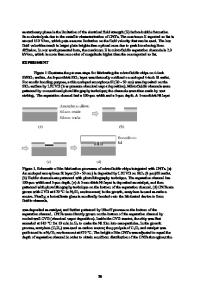Biochemical IC Chips Fabricated by Hybrid Microstereolithography
- PDF / 2,394,080 Bytes
- 12 Pages / 612 x 792 pts (letter) Page_size
- 47 Downloads / 332 Views
LL5.6.1
Biochemical IC Chips Fabricated by Hybrid Microstereolithography Koji Ikuta, Shoji Maruo, Tadahiro Hasegawa, Takao Adachi, Atsushi Takahashi, Kota Ikeda Department of Micro System Engineering, Graduate School of Engineering, Nagoya University Furo-cho, Chikusa-ku, Nagoya 464-8603, Japan ABSTRACT The world’s first microstereolithography named “IH process” was developed by Ikuta et al. in 1992. Several types of micro stereo lithography including Hybrid-IH process, Super-IH process and Two-photon IH process, have been also developed. Three-dimensional (3D) resolution has reached to 140 nm in the two-photon IH process. The super-IH process and the two-photon process enable direct writing of movable micromechanisms without assembling process or sacrificial layer technique. The hybrid-IH process provides various types of composite devices with other functional elements such as actuators and sensors. These IH processes can be widely used for making polymeric microdevices. We have applied these techniques to create new micro chemical device named “Biochemical IC Chip” proposed by Ikuta et al. in 1994. IH process enables to make the biochemical IC chip including real 3D micro fluidic channels. Various kinds of Biochemical IC chip such as micro pumps, switching valves, reactors, concentrators, have already been fabricated. In chip cell-free protein synthesis has been demonstrated by using biochemical IC chips. The biochemical IC chips will open new bioscience and medicine based on innovative technology. In this paper, we introduce several types of IH process and its application to biochemical IC chips. INTRODUCTION Conventional micromachining such as surface micromachining and LIGA process have been widely used to make various kinds of sensors and actuators. However, these methods have some limitations on fabrication of 3D microdevices demanded in recent applications such as micro total analysis systems (µ-TAS) and lab-on-a-chip devices. On the other hand, we have developed several types of microstereolithography to make truly 3D microstructures. The world’s first microstereolithography system called “IH process” was proposed and developed by Ikuta and Hirowatari in 1993 [1]. The IH process made possible the layer-by-layer process of 5 µm thickness with modifications to both the optical system and the characteristics of photopolymer. In 1996, mass productive microstereolithography named “Mass-IH process” was proposed and demonstrated [2]. Since this process uses an array of optical fibers to obtain multi-beam scanning with high accuracy, we can fabricate real 3D microstructures under mass and low cost production similar to silicon process. To fabricate functional microdevices, we have developed two-types of IH process named “Hybrid-IH process” and “Multi-polymer IH process”. The hybrid-IH process provides a composite microdevice with functional elements such as chemical microparts and actuators [3, 4]. The multi-polymer IH process can produce all-polymer microdevices such as optical waveguides and microvalves using m
Data Loading...










